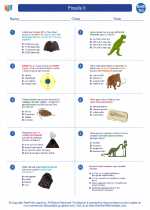Fossils II -> prisms
Definition of Prism
A prism is a three-dimensional geometric shape with two parallel and congruent polygonal bases and rectangular or parallelogram-shaped sides.
Types of Prisms
There are different types of prisms based on the shape of their bases, such as triangular prisms, rectangular prisms, pentagonal prisms, and hexagonal prisms.
Properties of Prisms
- Number of Faces: A prism has 5 or 6 faces, depending on whether the bases are counted as one or two faces.
- Vertices: Prisms have 6 to 8 vertices, depending on the number of sides of the bases.
- Edges: The number of edges in a prism ranges from 9 to 12, depending on the number of sides of the bases.
- Surface Area: The surface area of a prism can be calculated by adding the areas of its bases and the lateral faces.
- Volume: The volume of a prism is calculated by multiplying the area of the base by the height of the prism.
Formulas for Surface Area and Volume
The surface area (SA) and volume (V) of a prism can be calculated using the following formulas:
Surface Area (SA) = 2B + Ph, where B is the area of the base, P is the perimeter of the base, and h is the height of the prism.
Volume (V) = Bh, where B is the area of the base and h is the height of the prism.
Real-World Applications
Prisms are commonly found in everyday objects such as buildings, packaging boxes, and containers. Understanding prisms and their properties is essential for tasks involving measurement, construction, and design.
Example Problems
1. Calculate the surface area and volume of a rectangular prism with a base length of 4 cm, base width of 3 cm, and a height of 5 cm.
2. Find the total surface area of a triangular prism with a base side length of 6 cm, base height of 4 cm, and a prism height of 8 cm.
.


